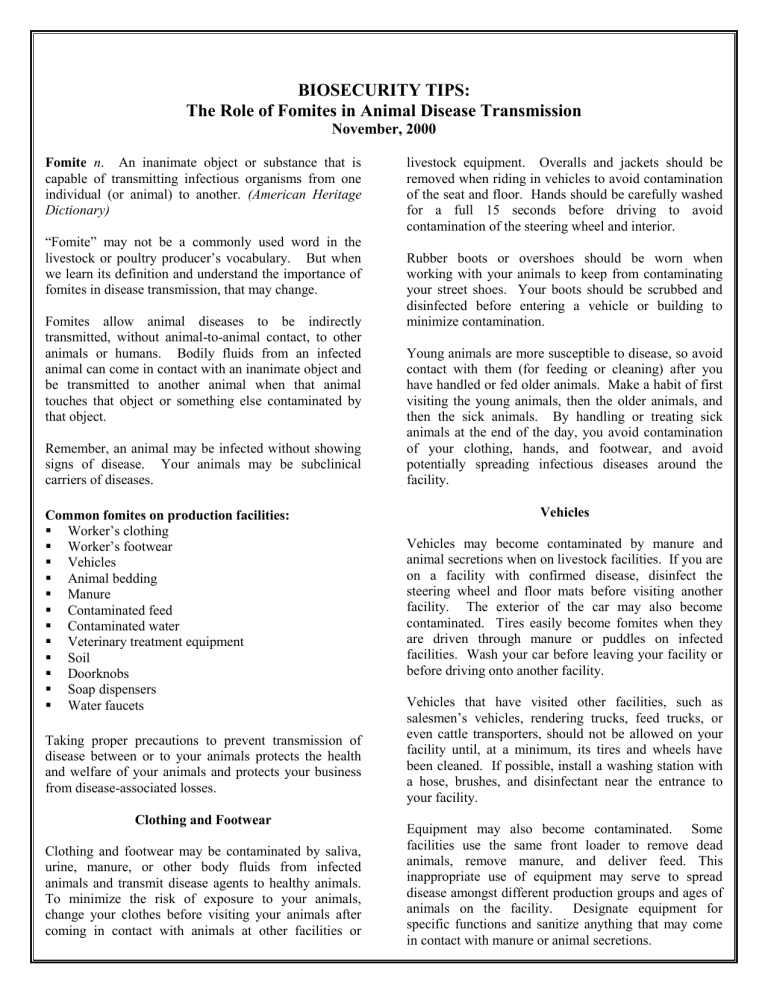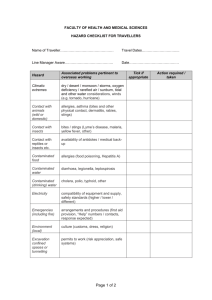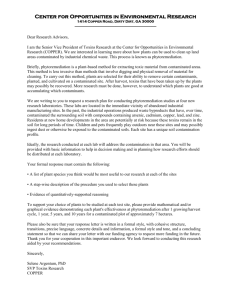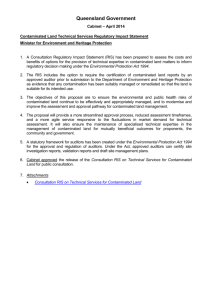The Role of Fomites in Animal Disease Transmission

BIOSECURITY TIPS:
The Role of Fomites in Animal Disease Transmission
November, 2000
Fomite n . An inanimate object or substance that is capable of transmitting infectious organisms from one individual (or animal) to another. (American Heritage
Dictionary)
“Fomite” may not be a commonly used word in the livestock or poultry producer’s vocabulary. But when we learn its definition and understand the importance of fomites in disease transmission, that may change.
Fomites allow animal diseases to be indirectly transmitted, without animal-to-animal contact, to other animals or humans. Bodily fluids from an infected animal can come in contact with an inanimate object and be transmitted to another animal when that animal touches that object or something else contaminated by that object.
Remember, an animal may be infected without showing signs of disease. Your animals may be subclinical carriers of diseases.
Common fomites on production facilities:
Worker’s clothing
Worker’s footwear
Vehicles
Animal bedding
Manure
Contaminated feed
Contaminated water
Veterinary treatment equipment
Soil
Doorknobs
Soap dispensers
Water faucets
Taking proper precautions to prevent transmission of disease between or to your animals protects the health and welfare of your animals and protects your business from disease-associated losses.
Clothing and Footwear
Clothing and footwear may be contaminated by saliva, urine, manure, or other body fluids from infected animals and transmit disease agents to healthy animals.
To minimize the risk of exposure to your animals, change your clothes before visiting your animals after coming in contact with animals at other facilities or livestock equipment. Overalls and jackets should be removed when riding in vehicles to avoid contamination of the seat and floor. Hands should be carefully washed for a full 15 seconds before driving to avoid contamination of the steering wheel and interior.
Rubber boots or overshoes should be worn when working with your animals to keep from contaminating your street shoes. Your boots should be scrubbed and disinfected before entering a vehicle or building to minimize contamination.
Young animals are more susceptible to disease, so avoid contact with them (for feeding or cleaning) after you have handled or fed older animals. Make a habit of first visiting the young animals, then the older animals, and then the sick animals. By handling or treating sick animals at the end of the day, you avoid contamination of your clothing, hands, and footwear, and avoid potentially spreading infectious diseases around the facility.
Vehicles
Vehicles may become contaminated by manure and animal secretions when on livestock facilities. If you are on a facility with confirmed disease, disinfect the steering wheel and floor mats before visiting another facility.
The exterior of the car may also become contaminated. Tires easily become fomites when they are driven through manure or puddles on infected facilities. Wash your car before leaving your facility or before driving onto another facility.
Vehicles that have visited other facilities, such as salesmen’s vehicles, rendering trucks, feed trucks, or even cattle transporters, should not be allowed on your facility until, at a minimum, its tires and wheels have been cleaned. If possible, install a washing station with a hose, brushes, and disinfectant near the entrance to your facility.
Equipment may also become contaminated. Some facilities use the same front loader to remove dead animals, remove manure, and deliver feed. This inappropriate use of equipment may serve to spread disease amongst different production groups and ages of animals on the facility. Designate equipment for specific functions and sanitize anything that may come in contact with manure or animal secretions.
Animal Bedding and Manure
Animal bedding is contaminated by manure and animal secretions. Animal bedding should be regularly replaced. If it is placed on top of concrete or another solid surface, that surface should be scraped and then disinfected with a high-pressure hot water and a disinfectant.
Feed and Water
Contaminated feed and water are proven sources of animal disease in production facilities. Feed can become contaminated in many ways. The raw ingredient may be contaminated, there may be contamination at the feed mill, equipment used to mix or distribute the feed may be contaminated, your animals may contaminate the feed with manure and saliva, or infected rodents and wild birds may defecate in the feed. Water may be contaminated in many of the same ways.
Producers must work with feed suppliers to assure that raw feed ingredients that they purchase are not contaminated with Salmonella and other bacteria. On the farm, they can minimize contamination. Have dedicated equipment to handle feed. Regularly clean and sanitize your feeding and watering equipment and water troughs.
Institute a rodent control program and minimize rodent access to feed, including feed in the bunk. Wild birds are a challenge for outdoor facilities. Protective nets, housing, and feeder covers may minimize the problem.
Facilities
If your hands are contaminated, anything you touch can become a fomite. Frequent handwashing is an important method of minimizing contamination of inanimate objects. All farm personnel should have ready access to handwashing facilities and be trained in proper handwashing techniques. Despite these precautions, frequently handled objects like doorknobs, record binders, and computer keyboards can become fomites.
When water faucets are turned on with contaminated hands, after the hands are washed, turning off the water will transfer the contamination back to the clean hands.
The ideal faucets for production facilities are footoperated. If that is not possible, paper towels used for drying hands should be used to turn off the faucet.
Visiting Other Facilities
Any place where stressed animals are congregated, including sale yards and livestock pavilions at county fairs, is a breeding ground for disease. Stressed animals are more likely to be spreading disease to other animals with depressed immune systems.
After visiting any facility with the same type of animals as your own, shower and change your clothes and footwear before handling or feeding your animals. Your clothes may be contaminated.
If you receive animals from a sale yard or other facility, quarantine them. Do not handle or feed your older animals after handling the new animals until you are sure the new animals are free of disease.
Developed by HJ Hamlen for the California Department of Food and
Agriculture, Animal Health Branch, Emergency Programs, 1220 N Street,
Room A-107, Sacramento, CA 95814.
For more information, contact:
Your local Extension Livestock Advisor.







